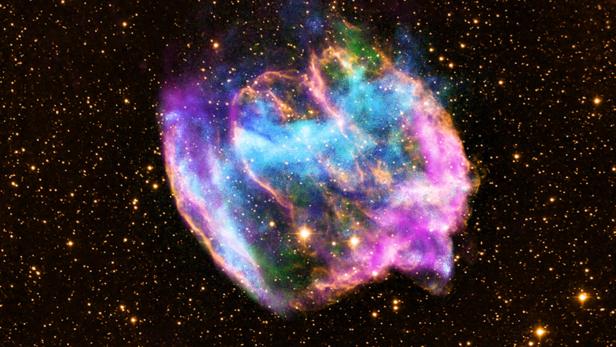
Supernova remnant W49B (symbolic image)
© X-ray: NASA/CXC/MIT/L.Lopez et al; Infrared: Palomar; Radio: NSF/NRAO/VLA
Astronomers have found a new way to Supernovae To get the way. This is what they found. 307 Events that have not been discovered before. And among them also 7 Supernovae are particularly rare.
Supernova Remnant (SNR) Expanding fogWhich originates from a supernova explosion. Material that remained from the explosion or accumulated after the cloud spreads collects there. A famous example of a signal-to-noise ratio (SNR) that can be seen with a telescope is the Crab Nebula.
➤ Read more: What is a supernova?
Rare oxygen-rich SNR found
Some rare nebulae are particularly rich in oxygen. So far only 8 Such beings in milky way and Magellanic Cloud How these oxygen-rich SNRs form and what type of supernova causes them have not yet been adequately investigated.
This could be addressed by the team's new research. Timo Kravtsov on European Southern Observatory (ESO) It changes. Your new way stimulates abilities Multi-Unit Spectroscopic Explorer (MUSE) At the Very Large Telescope (VLT) in Chile.
Emission lines reveal supernova remnants
The team looked for regions that showed signs of shocks like those that occur after a supernova. There they analyzed them. Emission linesThrough which the composition of these areas can be read using different wavelengths of light.
The areas circled in white are the newly discovered SNR regions. Green corresponds to hydrogen (H-alpha) emissions, red corresponds to sulfur (SII) emissions, and blue corresponds to oxygen (OIII).
© Kravtsov et al.
So they were able to get oxygen emissions. 35 Of the 307 newly discovered supernova remnants, 7 were found to be oxygen-rich after further analysis. The researchers compared their data with previously collected observations. X-rays Far away. The radiation is produced by the shock wave after the supernova.
➤ Read more: Researchers show for the first time what forms after a supernova
Some objects had a brightness slightly below the allowable limit. Ultra-bright X-ray sources (ULX)These point radiation sources shine brighter than stars before they become unstable. So far, no ULXs are known in the Milky Way.
Searching other galaxies
The researchers now plan to apply their new method to others. Nearby galaxies To apply. They hope to find more oxygen-rich SNRs. They want to learn more about the origin of these nebulae. The search was On arXiv preprint server It was previously published and is currently being reviewed.

“Social media evangelist. Baconaholic. Devoted reader. Twitter scholar. Avid coffee trailblazer.”








More Stories
Longest jets in the universe discovered – giant particle streams as long as 140 Milky Way galaxies in a row
Snapchat is upping the ante on augmented reality glasses
Börse Express – Snapchat Adds Augmented Reality Glasses